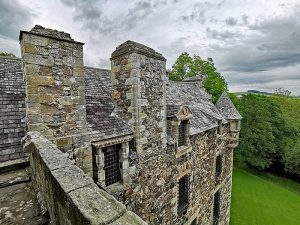It’s where she grew up and where her father and grandmother live.
Location: Caithness, Scotland
Owner: Thorfinn McGonagall; later, Einar McGonagall
Construction Date: ca 1440

Castle Isleif is located in the northeastern part of Caithness, Scotland, between the villages of John o’ Groats and Duncansby Head, about two miles from cliffs overlooking the Pentland Firth towards the Orkney Islands.
The first permanent edifice was probably built on the site around 1000 CE and was likely a wooden structure based on a motte-and-bailey plan, according to archaeological research carried out on the site by Marcus McGonagall I (1832–1899), and later by his grandson, Thorfinn McGonagall.
The name “Castle Isleif”, first recorded in 1156, likely reflected the Norse origin of the property’s original settlers.
The castle was partially destroyed around the time of the Battle of Tannach during the hostilities between clans Keith and Mackay, and Clan Gunn. It was rebuilt as a stone z-plan tower castle between 1440 and 1460.
The first known settlers of the area that would encompass Castle Isleif were descendants of Vikings that invaded the Kingdom of Alba in the ninth century CE. It is unknown if the original settlers were magical folk, but by the time they rose to the ranks of toiseachs to the Earls of Orkney, the magical identity of the property’s masters was established.
The best known of these toiseachs was Einar Thorbjornson, who served Thorfinn the Mighty during the latter’s war with Karl Hundason over the rule of Caithness. Thorbjornson may have used magic to help secure Thorfinn’s victory.
The first mention of a “Mac Conghail” as the lord of Castle Isleif comes from the Historia Gentis Scotorum Magicum (ca 1346). It is likely that the Norse owners of the original Castle Isleif assimilated with their Celtic neighbours sometime after Caithness became a tributary of King of the Scots subsequent to the Treaty of Perth in 1266.
House-elves attached to the McGonagall family lived in the castle from 1635 on.
Castle Isleif’s grounds include a large informal garden and an old dovecote dating from the sixteenth century.
Some members of the McGonagall family are buried in a small graveyard on the castle grounds.
The ground floor included the main entryway and entry hall, as well as the kitchen and servants’ (later house-elves’) quarters.
A large wooden staircase led to the upper floors of the castle.
The first floor housed the public rooms of the house, including a music room, library, and a great hall, which was partitioned off to become a smaller dining room and a drawing room, later used as Thorfinn McGonagall’s study.
The second floor comprised two bedrooms and, originally, two solars. In the 1860s, Drusus McGonagall (1800–1885) renovated the second-floor rooms, dividing them into three suites: two smaller bedrooms with attached dressing rooms, and one master suite with bedroom, dressing, and sitting rooms.
In the early 1900s, Marcus McGonagall II (1852–1923) eliminated the two garderobes on the second floor and installed modern magical plumbing throughout the castle, adding private baths to the bedrooms on the second and third floors.
The third floor included four bedrooms, one of which was used as the nursery and schoolroom in the modern era.
One of the bedrooms became known as the “Green Bedroom,” after ten-year-old Einar McGonagall placed a charm on it that made anyone who entered it feel inexplicably nauseated as a prank on an uncle he particularly disliked. Einar’s father, Thorfinn, lifted the charm when he discovered it, but the family thereafter referred to the room as the “Green Bedroom”.
Castle Isleif was protected by powerful charms, including blood wards, that prevented unauthorised access.
Like Hogwarts, it was enchanted to be largely unnoticeable by Muggles. Any who wandered too close would be seized by a feeling of danger. Apparition into or out of the house and grounds was impossible (except for house-elves); however, witches and wizards could Apparate to grounds within a mile of the house.
In 1920, Thorfinn McGonagall had Castle Isleif connected to the British Floo Network to allow his ailing father easier access to the Edinburgh and London galleries and libraries he enjoyed, as Apparition from the grounds had become too taxing.
The family routinely provided Portkeys for the use of visitors who preferred not to (or could not) Apparate.
Isleif is an Old Norse name, likely a derivative of Ísleifur, the given name of the first bishop of Iceland, Ísleifur Gissurarson (ca 1006–1080).

Lorem ipsum dolor sit amet, consectetur adipiscing elit. Ut elit tellus, luctus nec ullamcorper mattis, pulvinar dapibus leo.